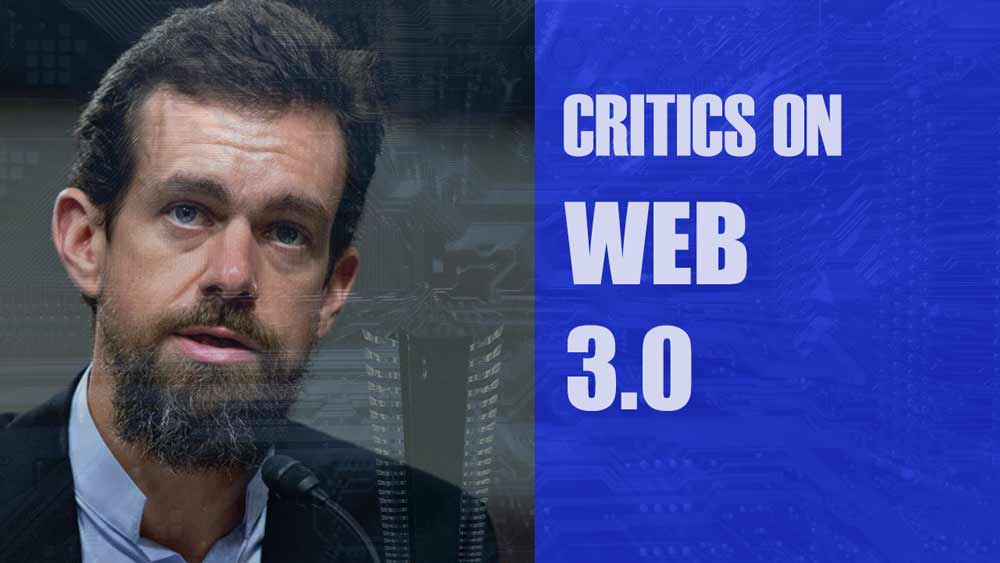What is Web3? – Critical view on web3.
The tech and crypto community has been talking about the potential applications of Web3. The general expectation among crypto traders and tech enthusiasts is that Web3 will provide users with a decentralized version of the internet built on blockchain technology.Blockchain technology is a key component of decentralized finance, cryptocurrencies, and non-fungible tokens (NFTs). Due to its excellent use case, it is only fitting that blockchain technology serves as the backbone for developing a decentralized internet service. However, despite several claims about the decentralized nature of Web3, several prominent tech experts hold the belief that the project is not as totally decentralized as it claims to be.These experts believe that Venture Capitalists funding the development of Web3 hold total control over the project. One of these critics is Jack Dorsey, CEO of Block (formerly Square) and former Twitter CEO. Another prominent critic of Web3 is Tesla founder and CEO Elon Musk.Later in this article, we will consider their criticisms of Web3. However, let us briefly discuss Web3 and its features to understand what this new project has to offer fully. Additionally, we will consider the principles behind cryptocurrencies and why there has been a constant push for total decentralization within the crypto space.
What is Web3.0 ?
Web3 is often described as the next version of the internet. Unlike previous versions, Web3 is expected to remove control over user data from big tech companies and offer that control to individual users. However, to fully under the functions of Web3, we need to consider previous versions of the internet and compare them with features that will come with Web3. First launched in the late 1990s, Web 1 was the first version of the Internet. Initially, the internet was simply a collection of links and websites homepages. As a result, most websites were not designed to feature human interaction. Thus, users of the first version of the internet could only read content on websites. Due to this function, Web 1 was often referred to as the read-only internet. However, users could post basic content on websites for other users to read in some cases. The launch of Web 2.0 took place between 2004 and 2005. This version of the internet is often described as the read/write version. In addition to reading content, Web 2.0 also allowed internet users to create and post their content on blog sites and social media platforms, among a host of other features.Despite the benefit attached to Web 2.0, this version of the internet allowed big tech companies to harvest users’ data for creating marketing campaigns and tailored advertisements based on the user data at their disposal. Many tech giants have greatly benefitted from unfettered access to user data. In most cases, these tech companies have breached data privacy laws repeatedly, resulting in fines from regulatory authorities. For example, in 2019, Facebook was slammed with a $5 billion fine by the Federal Trade Commission (FTC) for breaching data privacy laws. The result of privacy data breaches due to this misapplication Web 2.0 birthed the idea of a decentralised internet built on blockchain technology, which is now tagged as the upcoming Web 3.0.Despite seeking to correct the flaws of Web 2.0, many several prominent tech experts like Jack Dorsey and Elon Musk hold the belief that the project is not as decentralized as it claims to be. To understand the reason for their claims, let us briefly examine the principles behind cryptocurrencies and decentralized finance (DeFi).
Principles of Cryptocurrencies and Decentralized Finance (DeFi)
Decentralization is the main principle that guides most crypto assets and DeFi. When fully applied, systems that operate on the decentralization principle completely remove intermediaries or mediators from the transaction process. Additionally, the principle of decentralization means that cryptocurrencies and DeFi protocols are free from the control of centralized bodies or organizations. Simply put, this means that centralized organizations or bodies can not access user data on DeFi platforms or control and determine the value of cryptocurrencies. To fully achieve decentralisation, DeFi protocols use smart contracts to carry out transactions on their platforms as a replacement for intermediaries. Smart contracts are self-executing contracts that have terms of an agreement between two parties written directly into lines of code. The result of this is that the code directly controls the execution of the contract. Furthermore, all smart contract transactions are trackable, and any party can not reverse them. In addition to smart contracts, most Defi protocols use on-chain governance mechanisms to make collective decisions on their platform. The benefit of the on-chain governance model is that it allows stakeholders or investors in the DeFi protocol to vote directly on changes to the governance process. The use of smart contracts and on-chain governance mechanisms has been instrumental to the growth of the DeFi sector. Unless these principles are fully applied, no tech project can claim to be fully decentralized.
Criticisms Of Web3- Jack Dorsey’s Frown

In a series of tweets on December 21, 2021, former Twitter CEO Jack Dorsey criticised Web3 and the venture capitalists behind the project. In his opinion, Jack stated his belief that Venture capitalists and their liquidity providers own web3. Due to this assessment, Jack believes that Web3 is simply a centralized entity promoted as a decentralized version of the internet. This opinion expressed by Jack Dorsey was also supported by Tesla CEO Elon Musk, who also tweeted against tech companies promoting web3 technology. Although opposed to Web3, Jack Dorsey constantly promotes his belief in the potential growth of Bitcoin. Similarly, Elon Musk shares a strong affiliation with Dogecoin.These crypto-assets are built on and operate on the principle of complete decentralization. Additionally, both personalities are actively involved in several DeFi projects that are entirely decentralized. As a result, their comments on Web3 can not be ignored or overlooked. Despite their criticisms, Web3 has several potential applications that will add to everyday internet users’ experience. Many tech experts agree with this fact, and many are working to incorporate web3 applications into their digital products. For example, Meta (formerly Facebook) is currently working on creating deep compatibility with blockchain technology and Web3. Whether Web3 is truly decentralized or not will only be answered once the newest version of the internet has been launched and used consistently. Until then we keep on visiting the web3 foundation’s website or social media.









